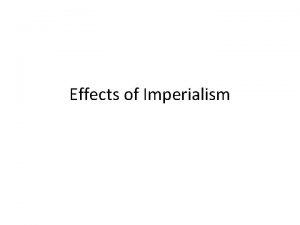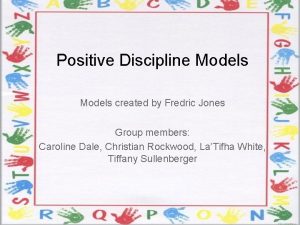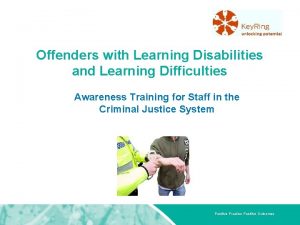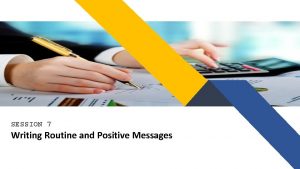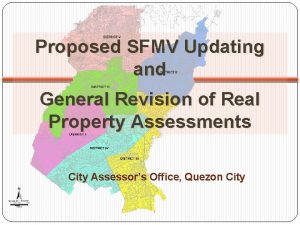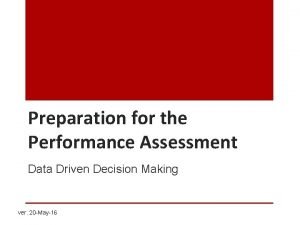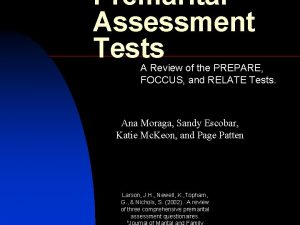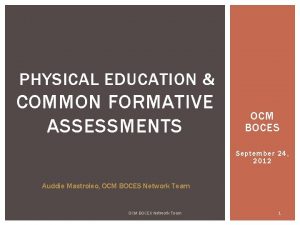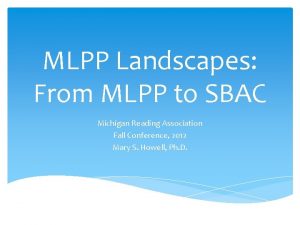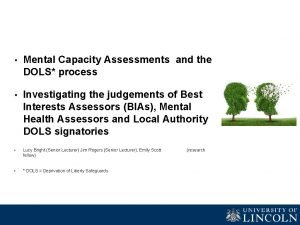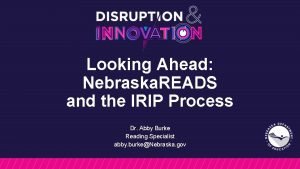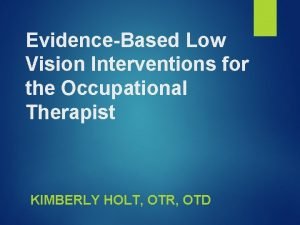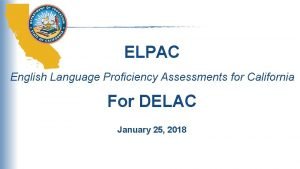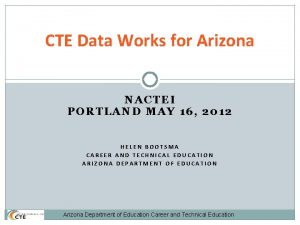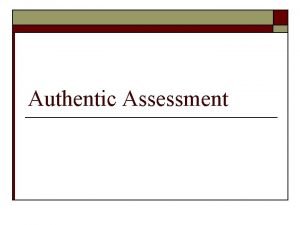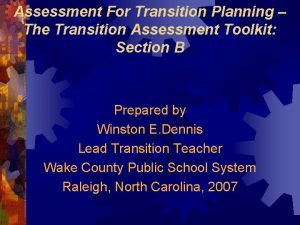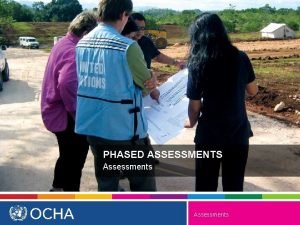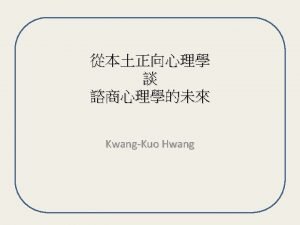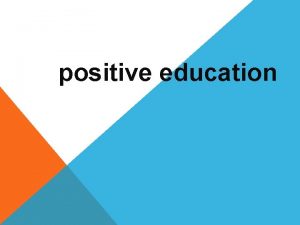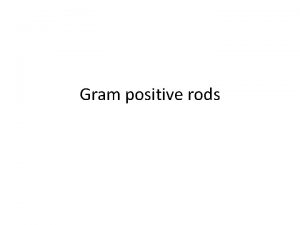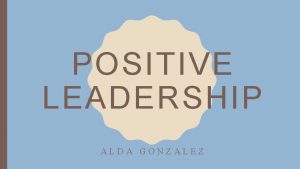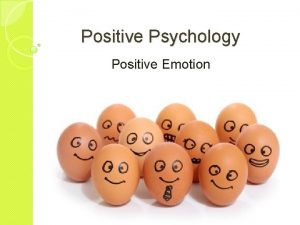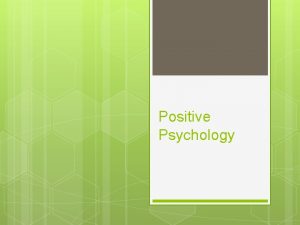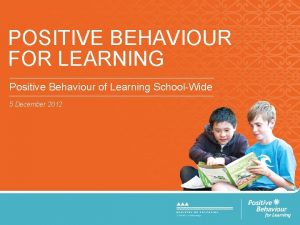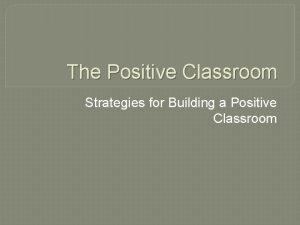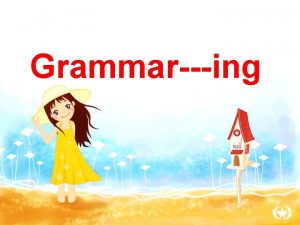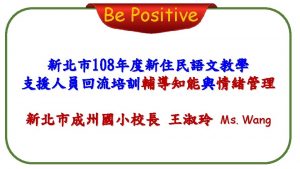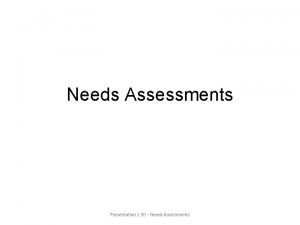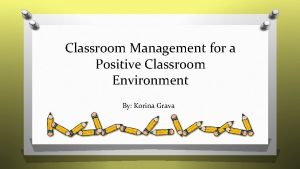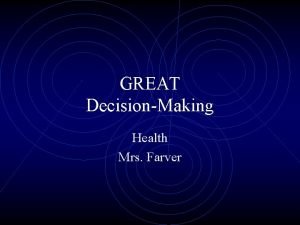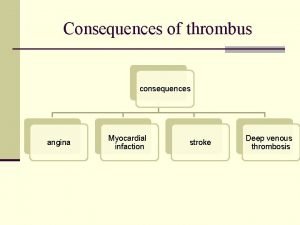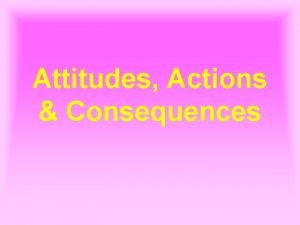Positive Consequences for Learning Classroom assessments should not




































































































- Slides: 100

Positive Consequences for Learning Classroom assessments should not only monitor student learning, they should also contribute to it. Assessment is often assumed to be an “after the fact” activity, the purpose of which is to check to see what students have learned. This type of checking is the main purpose of summative assessment. However, students are deprived of an important opportunity if their summative assessments and grades are good only for looking back and offer no information about their strengths and weaknesses, their study habits, and so on. In contrast, informing and nurturing learning are the main purposes of formative assessment. Students are deprived of an important opportunity if they do not have the opportunity to practice, gauge their progress, and receive feedback for every classroom learning outcome

Thus, both formative and, at least to some degree, summative assessment should provide useful information to students as they regulate their learning, decide what and how to study, decide how to revise work, and so on. Give students opportunities to use formative feedback after they receive it. Provide at least one more similar activity or assignment after students get feedback from a draft or practice activity. Students can thus use the feedback to make changes in their study habits, their writing, or other necessary learning tools.

Design summative assessments so that students can “show what they know. ” Assess students’ achievement of the learning goals, not extraneous or tangential material. Effective assessments use straightforward tasks and avoid trick questions. Tests and performance assessments should hold students Accountable only for knowledge and skills they have had an opportunity to learn. Students need not be tested on the exact same questions or problems that they completed in class. Assessing higher-order thinking, in particular, requires using novel material, but assessments should reflect the kind of thinking or the type of problems that they have practiced.

Maintain a learning-focused interpretation of assessment results. Cultivate a classroom atmosphere that values learning rather than scoring. Emphasize that formative assessment results are intended to help students improve and will not “count against them. ” For summative assessments, emphasize that the results are a summary of what each student has achieved to date, not labels of ability (e. g. , “smart” or “dumb”). Rather, the results are a snapshot of what students have achieved— with regard to particular learning outcomes—at one point in time. Click HERE for more readings

Topics and sub-topics • Demands of inclusive practice. • Importance of effective teaching for struggling learners. • What skills do I need/need to impart if I am to be effective, efficient and satisfied? Related background knowledge Your personal experience as an educator provides you with relevant background. Concepts to be learned • The balance of challenges and skills = ‘flow’. • Personal sustainability at work. Reasons for learning the information

I hope you are • more effective and more realistic about the demands you place on yourself. • more strategic. • make efficient with your time. • more comfortable and relaxed as an educator. New vocabulary ‘Flow’, ‘life balance’.

Organizational frameworks for the information • Balancing professional and personal aspirations. • Inclusive education. • The role and importance of ‘learning support’. • The teaching strategies used by individual teachers are important but they are only part of the picture. Desired learning outcomes • You will value the work you do even more. • You will have an increased understanding of ‘what works’ for students with learning difficulties and those who teach them. • You will be more realistic, focused, effective, efficient, confident and relaxed. • You will answer this question for yourself: “What will I do differently t as a result of participating in this session? ”

What skills are needed? Teaching skills It may be self-evident but I have to state that the most crucial set of skills relate to ‘how to teach’, and if you are a consultant, how to assist others so that they teach successfully. Most of the presentations at this conference focus on this topic. There is plenty of evidence that good teaching make a difference; that really good teaching make a huge difference; and that good teaching makes a difference even when it occurs in contexts that are less than ideal (e. g. as concluded by Fullan, 2006; Hattie 2005; Rowe 2003).

Teachers should • be outcomes-focused • use conspicuous strategies • teach essential principles • link and integrate material • engage their students • provide students with direct and scaffolded support when needed • systematically monitor students’ performance

Relationships In addition to teaching in ways that are consistent with the quality teaching literature, and being creative and flexible, good teachers put considerable effort into building relationships – with students, colleagues and the whole school community. Having good relationships at school, particularly with students, is one of the factors that many teachers cite as making it all worthwhile

Effective teachers tend to be expert in ‘managing up’ – a term that describes the assistance provided by teachers to their executive in order to achieve the school’s goals. ‘managing-up’ as a professional responsibility and certainly not subversive. If teachers are highly competent in an area that is important to their executive then their expertise gives them considerable influence. This influence can be used to get more time for writing reports, more time for planning with their assistant, reduced class size, increased resources and similar benefits

Care for yourself Simplify your role Teach to your strengths Check the match between your role and your skills Use relevant strategies from outside education Experiment & reflect

Many factors shape the quality of learning. These include the aptitude and motivation of individual students and their own approaches to learning (including to collaborative learning), the quality and diversity of the student body of which they are part, the curriculum they study, the calibre and strategies of those who teach them, the size and nature of their classes, the ways in which learning is encouraged by assessment processes and feedback, the learning resources

The importance of teaching and learning in universities has shifted from routine and somewhat token acknowledgment in government policy to a central place in the higher education policy agenda. How and with what success universities, business and government combine to achieve a strong knowledge economy will depend in particular on some major shifts in the way they interpret and respond to the changing needs and expectations of undergraduate students. This includes in particular the design and management of student learning experiences.

How teaching and learning are changing Many of the changes in the way students learn at university are well known although the nature and extent of their impact is not. As with almost every aspect of society the digital revolution has permeated universities, especially development and adoption of flexible delivery with web-based resources and online learning. The clearest indication of change is the commonplace use of technologies in lecture theatres and laboratories, and the routine design of courses on the assumption that students will have ready access to the internet. Students are now more likely to study in multiple settings: in large lecture theatres, in groups on collaborative exercises, in computer laboratories with two or three others in an online tutorial, or simply working at home alone. They are less likely to spend significant time in small group tutorials, or to have one-toone consultation with their lecturers

While students are increasingly using information and computer-based technologies it is not necessarily in ways that enhance their engagement with the learning experience. The extent to which the management of these flexible learning experiences using these resources is directed by changing conceptions of the way students learn is not clear. Likewise, our knowledge of the nature and extent of student use of technologies and its impact on their learning outcomes is still sketchy.

Engagement with learning occurs where students feel they are part of a group of students and academics committed to learning, where learning outside the classroom is considered as important as the timetabled and structured experience, and where students actively connect to the subject matter. Where once it was assumed that students would naturally form natural support groups it is now clear that the mix of part-time work, idiosyncratic timetables, and the accessibility of web-based resources requires lecturers and course designers to design learning experiences that encourage students to develop informal networks.

Second, and obviously related, is the growth in studentcentred and active learning approaches. This has been largely led by medical schools where problembased learning is now widely incorporated or in fact totally embraced in the leading schools. There is also now an emerging effort, especially in researchintensive universities, to connect research to undergraduate teaching, and the integration of practical experience in professional courses is more systematic.

Third, there is a growing awareness of the importance of e v i d e n c e - b a s e d approaches to the organisation of learning experiences. That means universities and academics routinely collecting evidence about how much their students have learned and modifying approaches accordingly. This has partly reinvigorated the demand to stick with first principles in guiding the improvement of teaching and learning.

Undergraduate students learn best when they: work with other students in a group whose main purpose is learning; get timely and informative feedback on their work; spend adequate time and focus on learning tasks; and are able to consult with academics about their study. These basics continue to hold true in the digital classroom. Without evidence-based approaches to teaching and learning, the improvement of teaching becomes a hit-andmiss exercise: and without systematic monitoring of student performance and progress there is little chance of institutional learning.

Nine principles to guide teaching and learning 1. An atmosphere of intellectual excitement 2. An intensive research culture permeating all teaching and learning activities 3. A vibrant and embracing social context 4. An international and culturally diverse curriculum and learning community 5. Explicit concern and support for individual development 6. Clear academic expectations and standards 7. Learning cycles of experimentation, feedback and assessment 8. Premium quality learning resources and technologies 9. An adaptive curriculum

The first four principles relate to the broad intellectual environment of the University while the remaining five describe specific components of the teaching and learning experience. Each principle is directly relevant to students’ experience of university life, regardless of whether they are undergraduate, postgraduate coursework or postgraduate research students. Teaching and learning programs, underpinned by these nine principles, are designed to develop distinctive attributes in graduates.

The Nine Principles is a living document that reflects the balance of evidence in the research literature according to which student learning is enriched when informed by their teachers’ research. The second of the Nine Principles is to create ‘An intensive research culture permeating all teaching and learning activities’. Research-based teaching occurs when teaching is enriched by the teacher’s own original research, so that not only does the content draw upon the teacher’s research in that area, but students are also exposed to the teacher’s research experiences and approaches.

University-wide review of assessment and grading practices and how these relate to the quality of student learning Effective teaching and learning in large classes is hard work. The faculty who teach large classes are chosen carefully for teaching excellence, supported by their departments, and rewarded for their contribution and motivation Many instructors agree that one of the most immediate differences in teaching a large class versus a small one is the planning and the time that course preparation requires. Decisions about context, course design, evaluation of student learning outcomes, grading, learning resources, assignments, and classroom decorum are magnified when preparing to teach and manage a large class.

Good university teaching and good business practice have much in common. Both are based on a reflective ‘plan, do and review’ continuous, quality improvement cycle. Both have identifiable philosophies and strategies focused on outcomes. The aim of good university teaching is good university learning.

The active involvement of students in constructing their own knowledge. As a consequence, good university teachers are the ‘guide on the side’, not the ‘sage on the stage’. Good lecturers resource students and facilitate the skills needed to complete their assignments - the vehicle for student learning. Work-based learning develops partnerships between universities and industry by providing student placements of varying length,

Testing for Gains Every time Critical Thinking was taught during the redevelopment process, students were tested before and after the semester with at least one, and sometimes more than one, objective test of critical thinking skills. This produced detailed, reliable information about the extent of gains, information which drove the next round of development. Evidence-Based Design Throughout, development of the Reason Approach was guided by evidence from education research and cognitive science. Current theories of cognitive skill acquisition shaped the overall design of the Reason approach; considerations from cognitive psychology and even the philosophy of mind influenced the design of the educational software, which was further refined in numerous rounds of usability testing.

Combining Research and Teaching In the Reason Project, there was an unusually close relationship between research and teaching. The lead instructor’s main research interest was critical thinking instruction in general, and the effectiveness of his own teaching in particular. In a virtuous cycle, this research fed directly into the design of the Reason Approach, which was itself a test bed and stimulus for further research. The melding of research and teaching overcame the tension often experienced by university instructors, in which research and teaching activities are largely separate and time spent on one comes at the expense of the other.

Teaching involves much more than what happens in a classroom or online: It is oriented towards, and is related to, high quality student learning, and includes planning, compatibility with the context, content knowledge, being a learner, and above all, a way of thinking about teaching and learning. Improving teaching involves all these elements.


1. Interest and enthusiasm for teaching and promoting student learning 2. Ability to arouse curiosity, stimulate independent learning and develop critical thought 3. Ability to organize course material and to present it cogently and imaginatively 4. Command of subject matter, including incorporation of recent developments 5. Innovation in design and delivery of content and course materials 6. Participation in effective and sympathetic guidance and advising of students 7. Provision of appropriate assessment, including worthwhile feedback 8. Ability to assist students from equity groups to participate and achieve success 9. Professional and systematic approach to teaching development 10. Participation in professional activities and research related to teaching

Most universities conduct annual staff appraisals which are generally linked to applications for salary increments, continuing appointment/tenure or promotion. Staff summarize their activities and achievements to line managers who make subjective judgments of their scope, quality and impact. Various teaching parameters are considered, the foremost being feedback from students using various instruments of evaluation. However, student perceptions of teaching do not always mean that effective learning has occurred.

Courses must undergo periodic review to remain contemporary and relevant, clients need to be identified and consulted, graduate satisfaction and career outcomes need to be determined, and managers need realistic (not idealistic) data to allocate resources. Academics do not experience equity in teaching workloads as research and service commitments vary between staff. Many faculties conduct teaching quality audits where a percentage of their budget depends on successfully addressing certain criteria.

Quality improvement Methods to improve quality must progress beyond reward and punishment. There are various local and national awards for teaching excellence. While such rewards acknowledge effort and performance, they are regarded as elitist without tangible benefits for everyone. Punishment and penalties are counterproductive and are contrary to workplace agreements except where breaches of law and professional conduct occur. Withholding increments and erecting barriers to career advancement are inappropriate and open to abuse by hostile managers. There is a growing trend to abolish tenure and introduce contractual employment where renewed appointment is dependent on satisfactory performance. The problem arises as to what constitutes satisfactory performance and who decides?

Effective teaching approaches which build common outcomes within a diverse student body include: • dedicated support classes focussed on academic expectations, providing a safe forum for questions; • detailed written guides explaining expectations, requirements and marking criteria; • face-to-face feedback during and after the assignment writing process; • explicitly encouraging the asking of questions; • a willingness to make questioning safer by offering small group and structured segments in tutorials and scheduling individual consultations; • the use of technical and formal language in preference to colloquialisms or abbreviations, • the thoughtful selection of examples, case studies and humorous references in order to minimise (or explain) local references and maximise international content.



The top three intellectual behaviours: Analysis, evaluation, and creating; are considered higher levels of thinking and help us to demonstrate our critical thinking. Analysis refers to the process of examining the parts of a whole, the causes and results of events, and the differences between phenomena. For example, an economics student may be asked to analyse the causes of the global financial crisis of 2008 -2009. To get a high mark, the student would have to do more than describe what happened. He/she would be expected to name the main factors, explain which of these were the most important, and consider how the crisis could have been avoided

Evaluation may seem the most difficult, because it involves expressing opinions about the work of other people or expressing a justification for choices or ideas. It must follow from the other types of thinking, because you must understand theories and ideas of a subject area in order to evaluate them successfully. For example, the engineering student solving a design problem that has many possible solutions. The student would choose the best solution by identifying, comparing and testing theories and ideas related to the design problem. Creating is the process of joining or combining information and ideas from different sources to create something new. To create, you must be familiar with existing knowledge and practices in your field and be able to take parts of them to combine in new ways. Consider education students designing lesson plans based on educational theories and combining techniques from different sources with their own ideas. Even if no single part of the plan is original, the 'mix' is unique.

What are you thinking? Before you start a course or an assignment, consider these questions: What do I already know? What do I want to learn about this subject? What assumptions, attitudes, values or beliefs do I have that may influence my thinking?

What is the current thinking on this topic? When you read in your discipline or listen to a lecture, ask yourself: Where do these ideas come from? Does your experience or current knowledge support these ideas? Is the information the same or different from claims made by others? What criteria can I use to test or verify this information? Check the requirements of your courses What are the lecturers' expectations of their students? What types of assessment are used? What grading criteria are used? What are the learning outcomes of each course?

Read strategically Look at the title, abstract, summary, introduction, and conclusion of your readings to decide whether you need to read all of the text, only some of it, or whether you can skip it altogether. For more on critical reading strategies Make notes as you read, using your own words. Always note the source of the text: by whom, where and when it was published. Write down any questions you have, or possible problems with the writer's ideas.

Work with classmates to discuss ideas You should always write your own assignments, but you can improve your understanding by discussing ideas and information with your peers and your tutors. Write regularly about your own ideas, thoughts and feelings on a topic. Writing helps you clarify your thinking in terms of relevance, reasoning, and accuracy. Some professional courses may also require reflective writing assignments, such as built environment, education, engineering, medicine and social work.

Find your voice Express your ideas and do not be afraid to take risks. The best assignments show original thought, even if your ideas differ from the marker's ideas. Remember to support your views with valid reasons and solid evidence.


Strategies teachers can use prior to instruction to determine what knowledge (correct or incorrect) students have about concepts or theories to be taught 1. Conduct quizzes (pretests). 2. Try to learn how students are going about solving problems or arriving at their answers. Knowing the ideas and/or strategies that students are using to arrive at an answer (whether the answer is right or wrong) can be very informative for the purposes of making instruction more effective. 3. Encourage your students to ask questions and then examine the content of those questions. 4. Ask students to define major concepts, then analyze their definitions for errors in logic or strategy (the rule) that are causing the students to make mistakes. 5. Use the technique of "differential diagnosis": Make at least two hypotheses about what students might be thinking, and then choose or create problems that can separate between them. According to Brown and Burton (1978), this approach avoids the problem of focusing too quickly on one hypothesis and then generating problems that confirm the hypothesis. 6. Use the technique of difficulty factors assessment (DFA) (see Rittle-Johnson & Koedinger, 2005) to identify which features of a problem are either causing student difficulty or facilitating student learning. 7. Present problems to students in which you systematically vary important features of the problem (Brown & Burton, 1978).

9. Provide common misconceptions among the answer choices on a quiz (i. e. , multiple choice) or in response to classroom questions. 10. Give “implicit-confidence” tests. These tests involve a simple modification of the traditional multiple choice test. (See Klymkowsky, Taylor, Spindler, & Garvin-Doxas, 2006). 11. Administer questionnaires in specific subject matter areas in order to identify whether a misconception is unique to a particular context or is due to a problem with general reasoning or language. 12. Administer a categorization/sorting task. 13. Have students model (draw or use props) their solutions (Bright, 1996) to a problem and analyze their models for pattern or strategy errors. 14. Use student memory/recall of problems and definitions as a window into their thinking. 15. When using an alternative assessment, be sure that it is measuring what you are hoping to gauge from the student. For example, if you have a student build a boat out of foil to demonstrate an understanding of buoyancy, they may still understand the concept/(buoyancy), but struggle at building model boats.

Don'ts: 1. Do not jump too quickly to one hypothesis about student thinking processes or reasoning. Prematurely focusing on one hypothesis about what a student may be thinking can cause you to be unaware of competing hypotheses that may provide a better explanation (Brown & Burton, 1978). 2. Do not stick with or lock onto only one type of response behavior a student may display. Vary problem features to determine whether the same response behavior is displayed under different problem conditions. 3. Do not make a diagnosis about students' logic, reasoning or thinking processes on the basis of their performance on one problem or one kind of problem. 4. When probing students' understanding, try to avoid asking only general, open-ended questions. And don't stop probing after asking one question. Follow-up questions can reveal the source of a misconception, or an error in reasoning or strategy selection. Follow-up questions are also important when a student gives the right answer. Remember that faulty thinking can occasionally lead to correct answers. 5. Do not offer unmerited praise for students who are underperforming due to low initial ability at a task. Though your intention may be noble, this can lower the instinctive expectations of these students if they believe you only feel they can do minimal work (Rattan, Good, & Dweck, 2012).

How to use information gathered from pre-instruction quizzes Analyzing responses to pretest questions can provide you with a good understanding of what your students are thinking: �Analyze correct responses. �Analyze errors by looking for patterns. Patterns can reveal the thinking (or rules) that students use that lead them to their mistakes.

Information on student strategies can be gleaned in several ways: �Use students’ own verbal self reports. �Analyze students’ overt behavior, such as their written work (Rittle-Johnson & Koedinger, 2005; Rittle-Johnson & Siegler, 1999) and journal writing (Vacc & Bright, 1999). �Ask questions — there is a relationship between good teacher questioning skills and student thinking (Moyer & Milewicz, 2002). Good questioning is a skill. When the purpose of questioning is making informed instructional decisions, teachers should interpret students’ responses to determine what students know, rather than whether or not their answers match the expected responses (Vacc & Bright, 1999). Data show that pre-service teachers may not be using competent questioning techniques (Moyer & Milewicz, 2002; Ralph, 1999 a, 1999 b). Moreover, even inservice teachers may rely too heavily on recall-level questions (Morrison & Lederman, 2003). �students about the problems they solve to determine Interviewhow they arrived at their answers (See Bright, 1996; Ginsburg, 1997; Ginsburg, Jacobs, & Lopez, 1998, Ginsburg & Pappas, 2004; Moyer & Milewicz, 2002). �Evaluate the probability that students may have misconceptions through measures like the Scaling Individuals and Classifying Misconceptions (SICM) model and use that feedback as a basis for tailoring instruction to their needs (Bradshaw & Templin, 2014). �Facilitate class discussions designed to elicit student misconceptions, challenge inaccuracies and emphasize a correct conceptual framework throughout instruction

Prepare important questions ahead of time. �Deliver questions clearly and concisely. �Pose questions that stimulate thinking. �Provide children with enough time to think about and prepare their answers. �Avoid asking questions that require one-word answers. From Vacc & Bright (1999) �Ask questions that require critical thinking (e. g. , ask students to compare different solution strategies). �Ask probing questions that refer specifically to what a student says, does or thinks in order to gain further information about students’ solution strategies (e. g. , “How did you know how many nickels and how many pennies to put down? ”). �Ask followup questions for both incorrect answers and correct answers.

From Cohen, Steele, & Ross (1999) �Follow up answers with constructive feedback that communicates high expectation that a student will be able to master the material being questioned if they do not yet understand it. You might begin an interview with open-ended questions that get students to examine and justify their answers: �How did you figure that out? �What were you thinking when you got that answer? �How would you explain to another student how you got your answer? �Can you give me another example to explain what you mean?

Then move to more focused or specific questions: �What was the first thing you thought of? �What did you do next? �Did you have any pictures in your head as you worked through that part of the problem? If students are having difficulty verbally expressing their ideas, you can also use more "recognition questions. " For these questions, the student does not have to produce the content, but rather the content is put into the question and the student need only respond to it in some way.

Use the probing with follow-up technique, where a variety of question types are used to further investigate the child's answers. This includes questioning both correct and incorrect responses, and use of specific questioning. Things to avoid in a diagnostic interview (from Moyer & Milewicz, 2002) �Avoid "check listing" in the interview. With check listing the teacher proceeds from one question to the next on the interview protocol, relying on a script and paying little attention to the student's responses Avoid instructing when you should be assessing. Instructing includes asking leading questions and providing hints about the answer. The use of leading questions can result in a guessing game in which the student concentrates more on figuring out what the interviewer is thinking than on explaining his/her own thinking. Instructing also means that the questioning itself is halted while the concept is retaught.

Difficulty factors assessment is a way to identify which features of a problem are either causing students difficulty or facilitating their learning

A useful definition of the type of critical thinking you need to develop at university level is The kind of thinking which seeks to explore questions about existing knowledge for issues which are not clearly defined and for which there are no clear-cut answers. In order to display critical thinking, students need to develop skills in ♦ ♦ interpreting: understanding the significance of data and to clarify its meaning analysing: breaking information down and recombining it in different ways reasoning: creating an argument through logical steps evaluating: judging the worth, credibility or strength of accounts.

Why is critical thinking important at university? In general, students who develop critical thinking skills are more able to ♦ achieve better marks ♦ become less dependent on teachers and textbooks ♦ create knowledge ♦ evaluate, challenge and change the structures in society Displaying critical thinking in reading and writing Reading Three important purposes of reading critically are ♦ to provide evidence to back up or challenge a point of view ♦ to evaluate the validity and importance of a text/ position ♦ to develop reflective thought and a tolerance for ambiguity


Writing Written assignments may call for Critical thinking either explicitly or implicitly. Explicit types of critical writing are generally known as critical reviews. These assignments directly ask you to evaluate some aspects of ♦ a literary text or artwork ♦ a research article ♦ an argument or interpretation of an issue, text or artwork.

Strategies for writing critical reviews While it will be necessary to summarise the ideas of the original text, you will also need to ♦ select sections of the text (e. g. thesis/ methodology/ conclusion)which are open to question ♦ comment (if possible from both a positive and negative perspective) on the section ♦ draw on other sources to back up your comments ♦ come to a conclusion on the overall worth/ validity etc of the original text Key instruction words for critical reviews include ♦ Critically analyse/ evaluate… ♦ Comment on the argument that. . . ♦ Review the film ‘ ‘ ♦ Write a critical review of the article ‘ ‘ ♦ Critique

Implicit types of critical writing At undergraduate level, critical writing typically refers to the genre of the persuasive essay in which a logical argument [ to a stated position/ issue ] is developed and presented. Critical thinking is a process that challenges an individual to use reflective, reasonable, rational thinking to gather, interpret and evaluate information in order to derive a judgment. The cognitive process of critical thinking brings to light and questions accepted’ views and assumptions and can offer alternative perspectives ♦ Consider viewpoints from a range of perspectives (e. g. male and female, different socioeconomic and ethnic groups) ♦ Use inclusive language (e. g. non-gender specific, non-absolute terms such as ‘often’ and ‘could’ rather than ‘always’ and ‘is’)





Displaying critical thinking in indirect and subtle ways It is possible to give your marker evidence that you are aware of different perspectives in subtle, yet powerful, ways. It is important to remember that critical writing does not necessarily have to challenge an entire perspective or try to set up an entirely different perspective. Text 1 is an example of critical writing where the writer has demonstrated critical thinking by opening up the possibility that an argument or evidence may be limited. Exercise 3 Identify the language used to display evidence of critical thinking in Texts 2 and 3 Text 1 Essay question: Compare and contrast indigenous and western traditions of learning Another difference between indigenous traditions of learning and the western academic tradition is in the area of access to knowledge. In the indigenous traditions, access to various kinds of knowledge is limited according to gender and according to whether elders judge you as responsible to use the knowledge wisely. In the Western Academic Tradition, access is, at least theoretically, open to everybody.

Text 2 Essay question: In what ways has Australia developed a positive relationship with Indonesia? The Australian government argues that it has developed a good relationship with Indonesia over the last twenty-five years. It argues that its policies have led to improved political, economic and military cooperation between the two countries, to the benefit of both. However, the critical issue is which sections of Australian society have cultivated these relations and with which sections of Indonesian society and who has actually benefited.

Text 3 Essay question “The professional role and status of pharmacists is under threat” Discuss While these factors have led to a fear that the professional role and status of pharmacists may be under threat, this view does not take into account the importance of consumers’ support for pharmacy. Evidence for strong public appreciation for the role of the pharmacist can be found in John Varnish’s study on the public’s perceptions of pharmacy as a profession 1. Although some problems exist in making generalisations from this study, it presents strong evidence that pharmacy is seen by consumers to fulfil the criteria necessary for an occupation to be seen as a profession

LEARNING CENTRE WORKSHOPS WHICH WILL SUPPORT YOU WITH SOME OF THE ISSUES RAISED IN THIS LECTURE: Details of workshop blocks and programs can be found at http: //www. usyd. edu. au/lc ♦ Introduction to critical reading ♦ Introduction to critical writing ♦ Quoting, paraphrasing and summarising evidence

Teaching methods used by the college and university staff interviewed, there was a clear difference in the tutors’ perception of their roles and responsibilities. Thus SF 2 explained that: “the role of the teacher … is to understand the nature of the syllabus, to reach classes effectively using a variety of different teaching styles and to make sure students make good progress. ” In contrast a university tutor replied to the same question by saying “we are responsible for the student’s learning experience. It’s up to us to engender an interest in the subject and to ensure that students receive adequate direction about how to access information. It’s our job to give them the opportunities even though we can’t make them use these. ”

For example SF 4 said that he expected learners: “To attend as often as possible, to have equipment and textbooks with them, to be able to answer to question and answer sessions [and] to achieve above the minimum target grade. ” HE 4 noted: “a good student is interested in the subject, attends classes, asks questions [and] will prepare for classes. ”


Thus in the college environment tutors see their role as teachers of the subject taking due regard to the needs of the individual student. However the heavy emphasis on performance targets within colleges, leads to increasing emphasis on achieving the qualification as the primary end point and to teaching strategies, which are highly supportive of the individual in order to optimise assessment outcomes. Under these conditions students will know what they are required to do and will feel relatively secure as the close relationship between the tutor and the student means that their learning is managed and closely monitored. It is possible that one of the LSC’s current initiatives on ‘Personalised learning’ may increase this further. In contrast, within the university setting the tutors were more likely to see their role as motivating students to develop an enthusiasm for the subject, together with independence, self confidence and problem-solving abilities. In contrast to the college environment, the effectiveness of teaching was not subject to formal assessment. Instead it was based on a system of reflection and self evaluation which was sometimes supplemented by informal feedback from other members of the programme team





Colleges and universities should prepare students to generate, apply and disseminate knowledge as well as to perform well professionally, which may be accomplished through curricula that promote students’ understanding of general and specific knowledge, development of critical and conceptual reasoning, integration of theory to practice, development of interpersonal, written and oral communication skills and the capacity to reflect on their own practices and learn from practical situations. Another explanation for failure to engage is that students are highly instrumental and are only motivated by assessment. This may not just be a problem of students in university since a similar concern was expressed by one of the college tutors interviewed. However there is a suggestion that the problem may be increased by the college experience since the pressure to cover the syllabus in a limited period of time and for students to achieve at least minimum target grades, often appeared to force the tutors themselves to become more instrumental and assessment focussed and reduces the time and opportunities available for a more relaxed and developmental approach.

Problem-Based Learning (PBL) Originated in the 1960 s at Mc. Master University Medical School, Canada, PBL is essentially a collaborative, constructivist, and contextualized learning and teaching approach that uses real-life problems to initiate, motivate and focus knowledge construction. According to Schmidt (1993), PBL is grounded on Jerome Bruner’s notion that epistemic (intrinsic) motivation acts as an internal force driving people to better understand the world and on John Dewey’s principle of autonomous learning and emphasis on learning in answer to – and in interaction with – real-life events. Indeed, PBL is based on the assumption that learning is not a process of reception, but of construction of new knowledge. It is supported by cognitive science theory that spouses that previous knowledge about something can determine the nature and the amount of information students can process and elaborate in order to be internalized (Regehr & Norman, 1996). In addition, PBL is supported by cognitive research results that suggest that meta-cognition and social factors have a strong influence on learning (Gijselaers, 1996).

This principle is also the pillar of the PBL process, which may be summarized as follows: (1)A problem is presented to students, who, in small groups, organize their ideas, evaluate it, define its nature and try to solve it with available knowledge; (2) then students discuss the problem and identify aspects of it that need clarification and research (learning issues); (3) subsequently they prioritize the issues and plan when, who, where and how these issues will be investigated; (4)when the students meet again, they share and explore the knowledge gathered about the learning issues and use it to propose an informed solution to the problem (if a satisfactory solution cannot be reached, they may have to restart the cycle); and (5) after finishing working with the problem, the students assess themselves, their peers (group members) and the process/problem (Barrows, 2001).

While students are required to take up more responsibility for their learning, teachers have to relinquish the role of imparter of established scientific knowledge and valuator of the knowledge reproduced by students. Additionally, teaching in a PBL environment is quite different from what takes place in higher education institutions. Faculty at these institutions, especially at research universities, usually plan and teach their classes in isolation and are more interested in research than in teaching, a familiar depiction of teaching in engineering education.

PBL teachers should, instead of merely transmitting information, interact with the students at the meta-cognitive level, questioning superficial reasoning and vague and erroneous Ribeiro: The Pros and Cons of PBL from the Teacher’s Standpoint concepts (Savery & Duffy, 1998). This new role as co-learner, guide and facilitator in the construction of knowledge is one of the great challenges that PBL poses to teachers and institutions. Also, the literature on PBL indicates that teaching demands more participation, planning, cooperation with colleagues, administrators, employers of students and society, and shared decision-making in this educational environment lecture based ones. approach than in conventional,

Among several existing modes of continued education at the workplace, the collaboration between educational researchers and teachers has been indicated as one that best favours the professional development of both parties (Mizukami et al. 2002). This is because collaboration between teachers and researchers provides them with opportunities to reflect on their practice, reveal opinions and criticisms, and support each other’s changes.

Finally, while not wishing to imply that PBL teachers can do without formal pedagogic training, it appears that this approach, per se, may be an important tool in fostering the development of their knowledge base (Quinlan, 2003). Shulman (1987) defines the teacher knowledge base as comprising content knowledge, general pedagogical knowledge, curriculum knowledge, knowledge of students and their characteristics, knowledge of the educational context, knowledge of educational ends, and pedagogical content knowledge (i. e. , how teachers combine their content knowledge with other types of knowledge to promote students’ learning). Because a large amount of professional knowledge is believed to be constructed through a process of reflection on practice the on-going assessment and feedback activities inherent to PBL may actually boost the development of the teacher knowledge base.

Implementation of PBL The class was divided into two segments. In the second half of the class a problem was introduced to self-directed groups of 4 -5 students (alternately assuming the roles of leader, spokesperson, scribe and active members), who went on to identify the problem, brainstorm and hypothesize its causes, attempt to solve it with their available knowledge, determine new learning needs, and plan their self-directed work for the following week. During this phase the Teacher acted as a “floating” facilitator, i. e. , he went around the class, from group to group, checking their progress, questioning their common sense/equivocal understanding of the situation in question, and solving doubts about the PBL process. In the first half of the subsequent class, the groups (spokespersons) presented and defended their solutions before the whole class. In order to close the PBL cycle, after their presentations the Teacher commented on the appropriateness of the solutions and formal aspects of the presentations.


A quality teacher is one who has a positive effect on student learning and development through a combination of content mastery, command of a broad set of pedagogic skills, and communications/interpersonal skills. Quality teachers are life-long learners in their subject areas, teach with commitment, and are reflective upon their teaching practice. They transfer knowledge of their subject matter and the learning process through good communication, diagnostic skills, understanding of different learning styles and cultural influences, knowledge about child development, and the ability to marshal a broad array of techniques to meet student needs. They set high expectations and support students in achieving them. They establish an environment conducive to learning, and leverage available resources outside as well as inside the classroom

Higher education institutions use performance indicators for four primary reasons: • To monitor their own performance for comparative purposes • To facilitate the assessment and evaluation of institutional operations • To provide information for external quality assurance audits, and • To provide information to the government for accountability and reporting purposes (Rowe, 2004). Performance indicators used at the national level are designed to: • • Ensure accountability for public funds Improve the quality of higher education provision Stimulate competition within and between institutions Verify the quality of new institutions Assign institutional status Underwrite transfer of authority between the state and institutions, and Facilitate international comparisons (Fisher et al, 2000).

Defining performance indicators Three kinds of indicators have been noted by Cave, Hanney, Henkel and Kogan (1997). • Simple indicators are usually expressed in the form of absolute figures and are intended to provide a relatively unbiased description of a situation or process. • Performance indicators differ from simple indicators in that they imply a point of reference; for example, a standard, objective, assessment, or comparator, and are therefore relative rather than absolute in character. Although a simple indicator is the more neutral of the two, it may become a performance indicator if a value judgment is involved. • General indicators are commonly externally driven and are not indicators in the strict sense; they are frequently opinions, survey findings or general statistics.

Quantitative Indicators Quantitative indicators are defined as those associated with the measurement of quantity or amount, and are expressed as numerical values; something to which meaning or value is given by assigning it a number. These include the input and output performance indicators. Input indicators reflect the human, financial and physical resources involved in supporting institutional programmes, activities and services. Limitations concerning input indicators surround their inability to determine the quality of teaching and learning without extensive interpretation. For example, an indicator such as resource allocation should be interpreted with enrolment data (to determine resource to student ratio), resource quality (i. e. condition) and conceptual range (e. g. library book topics) to determine teaching and learning quality. Output indicators are subject to similar limitations. Output data reflects the quantity of outcomes produced, including immediate measurable results, and direct consequences of activities implemented to produce such results (Burke, 1998).

Qualitative indicators are associated with observation based descriptions, rather than an exact numerical measurement or value. They relate to or involve comparisons based on qualities or non-numerical data such as the policies and processes for assessing student learning, the experience of a learning community, or the content of a mission statement. Outcome and process indicators lie within the classification of qualitative measures. These performance indicators typically do not involve generating the quantity of outcomes in the form of numerical data, but measure complex processes and results in terms of their quality and impact. Outcome indicators Outcome measures focus on the quality of educational program, activity and service benefits for all stakeholders.

Process indicators are those which include the means used to deliver educational programmes, activities and services within the institutional environment (Burke, 1998). These measurements look at how the system operates within its particular context, accounting for institutional diversity, a common confounding factor in inter- and intra-institutional comparison.

Teaching practice (Chalmers & Thomson, 2008) are: 1. Mission, Vision and Objectives 2. Teaching and Learning Plans and Policies (summary of those present) 3. Teaching and Learning Indicators (as measured and used at each institution) 4. Internal and External Performance Funds for Teaching and Learning (such as the LTPF, or opportunities for faculties to be allocated grants) 5. Organisational Unit Review (includes Disciplines, Divisions, Faculties, Schools, Centres) 6. Curriculum Review (includes units, unitsets, programs) 7. Assessment and Feedback Policies

8. Graduate Attribute Statement (and how this is embedded and assessed in courses) 9. Student Experience (explores the provision of resources, particularly those for target groups such as international and first year students) 10. Professional Development (outlines support provided for staff, such as workshops and peer review and more formal programs such as the Graduate Certificate in Higher Education) 11. Appointment and Promotion Criteria (details teaching, research and service requirements at each level) 12. Review of Academic Staff (summary of measures, frequency, and implications of performance reviews) 13. Recognition of excellence in teaching and enhancing the student learning experience (Details eligibility, remuneration and requirements of Awards, Grants, Citations and Fellowships recipients)

Values of the Quality Teaching and Learning Quality Indicators Project Global value • Values research and teaching as the heartland of all university activities Institutional values • Values diversity over standardisation and comparability • Values the expectation that learning in higher education should be active, cooperative and intellectually challenging • Values trust and openness at all levels • Values equity principles and practices for both staff and students • Values creative renewal opportunities for staff and students Measures of performance values • Values a teaching quality framework as an opportunity for development and enhancement • Values measures and indicators that contribute to the development of good/effective teaching and learning practice • Values good judgement that is aided by the use of performance indicators. • Values an evidence based approach to decision making • Values performance indicators that can contribute to/ or be generalised to the wider sector


There are four levels developed in the tables of the framework: • • Institution-wide Faculty Department/program Teacher/Individual


Project Deliverables and Outcomes • Contribution to scholarship on teaching and learning indicators • Testing a framework and model of teaching quality indicators, trialled in different types of universities • Building a shared language regarding teaching performance • A multilevel approach to teaching quality • Improved links and increased transparency to reward and recognise quality teaching and learning throughout the university • Enhanced opportunities and tools for benchmarking • Opportunity for institutional renewal • A core set of indicators that can be shared between institutions • A core set of materials that can be used to undertake to process of developing and embedding institutional indicators around the framework.

Research-Based Teacher Education (1) To hold the national conference of university-based teacher education providers (2) To subsidize research on university-based teacher education. (3) To plan, organize, and carry out research projects on universitybased teacher education. (4) To publish the annual bulletin (5) To present recommendations and suggestions on teacher education to the Ministry of Education to inform policy making
 Positive consequences of assessment on students
Positive consequences of assessment on students Positive consequences of imperialism
Positive consequences of imperialism Sourima mal
Sourima mal Not genuine, not true, not valid
Not genuine, not true, not valid Fredric jones positive classroom discipline
Fredric jones positive classroom discipline Fredric jones positive classroom management
Fredric jones positive classroom management Creating a positive classroom atmosphere
Creating a positive classroom atmosphere Cuadro comparativo e-learning m-learning b-learning
Cuadro comparativo e-learning m-learning b-learning Staphylococcus shape
Staphylococcus shape What's 8 + 5
What's 8 + 5 Positive practice positive outcomes
Positive practice positive outcomes Routine communication examples
Routine communication examples Advantages of learning outside the classroom
Advantages of learning outside the classroom Advantages of learning outside the classroom
Advantages of learning outside the classroom Classroom strategies for interactive learning
Classroom strategies for interactive learning Formuö
Formuö Novell typiska drag
Novell typiska drag Nationell inriktning för artificiell intelligens
Nationell inriktning för artificiell intelligens Vad står k.r.å.k.a.n för
Vad står k.r.å.k.a.n för Varför kallas perioden 1918-1939 för mellankrigstiden
Varför kallas perioden 1918-1939 för mellankrigstiden En lathund för arbete med kontinuitetshantering
En lathund för arbete med kontinuitetshantering Adressändring ideell förening
Adressändring ideell förening Tidböcker
Tidböcker Sura för anatom
Sura för anatom Densitet vatten
Densitet vatten Datorkunskap för nybörjare
Datorkunskap för nybörjare Boverket ka
Boverket ka Att skriva debattartikel
Att skriva debattartikel För och nackdelar med firo
För och nackdelar med firo Nyckelkompetenser för livslångt lärande
Nyckelkompetenser för livslångt lärande Påbyggnader för flakfordon
Påbyggnader för flakfordon Tryck formel
Tryck formel Publik sektor
Publik sektor Kyssande vind
Kyssande vind Presentera för publik crossboss
Presentera för publik crossboss Argument för teckenspråk som minoritetsspråk
Argument för teckenspråk som minoritetsspråk Plats för toran ark
Plats för toran ark Klassificeringsstruktur för kommunala verksamheter
Klassificeringsstruktur för kommunala verksamheter Luftstrupen för medicinare
Luftstrupen för medicinare Claes martinsson
Claes martinsson Centrum för kunskap och säkerhet
Centrum för kunskap och säkerhet Verifikationsplan
Verifikationsplan Mat för idrottare
Mat för idrottare Verktyg för automatisering av utbetalningar
Verktyg för automatisering av utbetalningar Rutin för avvikelsehantering
Rutin för avvikelsehantering Smärtskolan kunskap för livet
Smärtskolan kunskap för livet Ministerstyre för och nackdelar
Ministerstyre för och nackdelar Tack för att ni har lyssnat
Tack för att ni har lyssnat Referat mall
Referat mall Redogör för vad psykologi är
Redogör för vad psykologi är Borstål, egenskaper
Borstål, egenskaper Tack för att ni har lyssnat
Tack för att ni har lyssnat Borra hål för knoppar
Borra hål för knoppar Vilken grundregel finns det för tronföljden i sverige?
Vilken grundregel finns det för tronföljden i sverige? Varians
Varians Tack för att ni har lyssnat
Tack för att ni har lyssnat Rita perspektiv
Rita perspektiv Verksamhetsanalys exempel
Verksamhetsanalys exempel Tobinskatten för och nackdelar
Tobinskatten för och nackdelar Toppslätskivling effekt
Toppslätskivling effekt Modell för handledningsprocess
Modell för handledningsprocess Egg för emanuel
Egg för emanuel Elektronik för barn
Elektronik för barn Antikt plagg
Antikt plagg Strategi för svensk viltförvaltning
Strategi för svensk viltförvaltning Kung som dog 1611
Kung som dog 1611 Indikation för kejsarsnitt på moderns önskan
Indikation för kejsarsnitt på moderns önskan Sju för caesar
Sju för caesar Tack för att ni lyssnade
Tack för att ni lyssnade Multiplikation med decimaltal uppgifter
Multiplikation med decimaltal uppgifter Haiku dikt exempel
Haiku dikt exempel Inköpsprocessen steg för steg
Inköpsprocessen steg för steg Rådet för byggkompetens
Rådet för byggkompetens Etik och ledarskap etisk kod för chefer
Etik och ledarskap etisk kod för chefer Hur stor skarns är det för ett barn att få cancer
Hur stor skarns är det för ett barn att få cancer Myndigheten för delaktighet
Myndigheten för delaktighet Frgar
Frgar Sju principer för tillitsbaserad styrning
Sju principer för tillitsbaserad styrning Läkarutlåtande för livränta
Läkarutlåtande för livränta Punkthöjd karttecken
Punkthöjd karttecken Geometri för barn
Geometri för barn Shaktismen
Shaktismen Biologiska arvet
Biologiska arvet Bris för vuxna
Bris för vuxna Bamse för de yngsta
Bamse för de yngsta General revision of assessments and property classification
General revision of assessments and property classification Performance assessment examples
Performance assessment examples Premarital tests or assessments
Premarital tests or assessments Common formative assessment examples
Common formative assessment examples Process oriented learning competencies
Process oriented learning competencies Mlpp assessments
Mlpp assessments Six dols assessments
Six dols assessments Irip
Irip Strengths and weaknesses of formal assessments
Strengths and weaknesses of formal assessments Eccentric viewing techniques occupational therapy
Eccentric viewing techniques occupational therapy Elpac scores meaning
Elpac scores meaning Cte technical skills assessments.azed.gov/student
Cte technical skills assessments.azed.gov/student Creative arts grade 6 lesson plan term 2
Creative arts grade 6 lesson plan term 2 Common core institute
Common core institute Authentic evaluation definition
Authentic evaluation definition Formal and informal assessment
Formal and informal assessment

